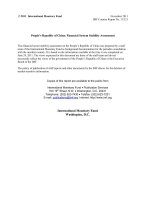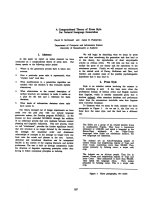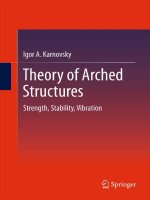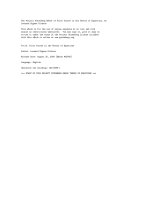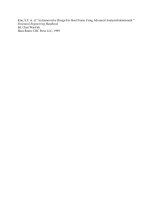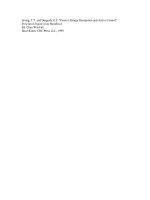Theory of Arched Structures: Strength, Stability, Vibration ppt
Bạn đang xem bản rút gọn của tài liệu. Xem và tải ngay bản đầy đủ của tài liệu tại đây (3.21 MB, 458 trang )
Theory of Arched Structures
Igor A. Karnovsky
Theory of Arched Structures
Strength, Stability, Vibration
Igor A. Karnovsky
Northview Pl 811
V3J 3R4 Coquitlam
Canada
ISBN 978-1-4614-0468-2 e-ISBN 978-1-4614-0469-9
DOI 10.1007/978-1-4614-0469-9
Springer New York Dordrecht Heidelberg London
Library of Congress Control Number: 2011937582
# Springer Science+Business Media, LLC 2012
All rights reserved. This work may not be translated or copied in whole or in part without the written
permission of the publisher (Springer Science+Business Media, LLC, 233 Spring Street, New York,
NY 10013, USA), except for brief excerpts in connection with reviews or scholarly analysis. Use in
connection with any form of information storage and retrieval, electronic adaptation, computer software,
or by similar or dissimilar methodology now known or hereafter developed is forbidden.
The use in this publication of trade names, trademarks, service marks, and similar terms, even if they
are not identified as such, is not to be taken as an expression of opinion as to whether or not they are
subject to proprietary rights.
Printed on acid-free paper
Springer is part of Springer Science+Business Media (www.springer.com)
In memory of Prof. Anatoly B. MorgaevskyPreface
In modern engineering, as a basis of construction, arches have a diverse range of
applications. Today the theory of arches has reached a level that is suitable for most
engineering applications. Many methods pertaining to arch analysis can be found in
scientific literature. However, most of this material is published in highly
specialized journals, obscure manuals, and inaccessible books. This is not
surprising, as the intensive development of arch theory, particularly stability and
vibration have mostly occurred in the 1940s to the 1960s. Therefore, most engineers
lack the opportunity to utilize these developments in their practice.
The author has committed to the goal of presenting a book which encompasses
essential and tested methods on fundamental methods of arch analysis and equally
important problems.
The objective of the Book is to provide to readers with detailed procedures for analysis of
the strength, stability, and vibration of various types of arched structures, using exact
analytical methods of classical Structural Analysis.
In 2004, professor L.A. Godoy published the article “Arches: A Neglected Topic
in Structural Analysis Courses.” This in-depth investigati on highlights a deep rift
between the modern level of development of arch theory and the level of presenta-
tion of this theory in existing material on structural analysis.
In 2009, the author of this book, with co-author O. Lebed published the textbook
“Advanced Methods of Structural Analysis” (Springer), in which arch theory is
presented in a much greater depth and volume than in existing textbooks. However,
the issue of producing a single book which covers both general and specialized
problems of arches remained unsolved. Th e book presented here sheds light on
issues of strength, stability, and vibrations, as well as special problems of arches
and arched structures.
In this book special attention is directed toward the discussion of fundamental
properties of structures. An engineer who is armed with fundamental knowledge
and means of computation is essentially set to succeed in modern day engineering.
Solutions of problems of strength, stability, and vibrations of arch es in most cases
vii
are broken down to basi c formulas which can be easily applied to engineering
practice.
This book is based on the author’s experience as a teacher and consultant in
structural mechanics. It is intended for senior undergraduate students in structural
engineering and for postgraduate students who are concerned with different pro-
blems of arches structures. The book will be a useful reference for engineers in the
structural industry.
Vancouver, Canada Igor A. Karnovsky
viii Preface
Distribution of Material in the Book
This book contains an introduction, four parts (nine chapters), and an appendix.
The first part “Strength” contains three chapters. Chapter 1 is devoted to
fundamental methods of determining displacement of elastic structures in general
accompanied by examples specifically for arches.
Chapter 2 covers the analysis of three-hinged arches, while analysis of redundant
arches is considered in Chap. 3; in these chapters a special attention is dedicated to
the analysis of arched structures using influence lines.
Second part “Stability” contains two chapters. Chapter 4 provides analytical
methods of the stability of arches. These methods are based on the integration of
differential equations.
Chapter 5 presents Smirnov’s matrix method and approximate method. Approx-
imate method is based on the approximation of the arch by straight members with
subsequent application of the precise displacement method in canonical form.
The third part, “Vibration” contains two chapters. Chapter 6 deals with compu-
tation of eigenvalues and eigenfunctions for arches. For analysis of the circular
uniform arch, Lamb’s differential equation is used; for analysis of parabolic
uniform arch the Rabinovich’s model is applied. The frequency of vibration for
arches with different ratio “rise/span” of an arch are presented on the basis of this
model.
Chapter 7 presents forced vibrations of arches.
The fourth part of the book, “Special Topics” holds the goal of presenting
introductory information regarding problems which until now have only been
discussed in specialized literature. Chapter 8 contains the static nonlinear problems.
They are plastic analysis of the arches and arched structures with one-sided con-
straints. Chapter 9 is devoted to dynamical stability of arches, and dynamics of
arched structures subjected to moving inertial load.
Finally, the appendix contains the fundamental tabulated data essential for
engineering practice involving arches.
Sections 2.1, 2.2, 2.4, and 2.6 were written by Olga Lebed.
ix
First of all I must thank professor L.A. Godoy (University of Puerto Rico at
Mayaguez) and Steven Elliot (Senior Editor, Springer) who stimulated the creation
of this book.
I wish to express deep gratitude to Olga Lebed (Condor Rebar Consultants,
Vancouver, Canada) for the very constructive discussions of the book, organiza-
tional assistance, and writing four sections of the book.
A number of friends and colleagues have helped me directly or indirectly;
my sincere gratitude to professors Valeriy A. Baranenko (Chemical Technology
University, Ukraine), Jurij G. Kreimer (Civil Engineering University, Ukraine),
Vladimir M. Ovsjanko (Polytechnical University, Belorussia), P. Eng Tat’jana
Volina (Ukraine), as well as to members of the Russian National Library (Moscow)
for helping with the pursuit of difficult-to-access literature and documents.
I wish to express deep gratitude to Evgeniy Lebed (University of British
Columbia, Canada) for productive discussions and helpful criticism as well as
assisting with many numerical calculations and validati on of results.
Many thanks to Tamara Moldon (Vancouver, Canada) for editing assistance.
I would like to thank all the staff of Springer who contributed to this project.
Finally, I would like to thank my relatives, many friends, and colleagues, who
have supported me through all stages of research and development of this book.
The author appreciates comments and suggestions to improve the current edi-
tion. All construc tive criticism will be accepted with gratitude.
xi
Preface vii
Introduction xix
Part I Strength Analysis
1 Deflections of Elastic Structures 3
1.1 General 3
1.2 Initial Parameters Method 5
1.3 Maxwell–Mohr Integral 10
1.3.1 Deflection Due to External Loads 10
1.3.2 Deflections Due to Change of Temperature 15
1.4 Graph Multiplication Method 18
1.4.1 Vereshchagin Rule 19
1.4.2 Trapezoid and Simpson Rules 20
1.4.3 Signs Rule 21
1.5 Maxwell–Mohr Formula for Curvilinear Rods 24
1.6 Elastic Loads Method 26
1.6.1 Computation of Elastic Load 26
1.6.2 Expanded Form for Elastic Loads 30
1.7 Differential Relationships for Curvilinear Rods 36
1.7.1 Relationships Between Internal Forces 36
1.7.2 Relationships Between Displacements and Strains 39
1.7.3 Lamb’s Equation 41
1.8 Reciprocal Theorems 42
1.8.1 Theorem of Reciprocal Works (B etti Theorem) 42
1.8.2 Theorem of Reciprocal Displacements
(Maxwell Theorem) 43
1.8.3 Theorem of Reciprocal Reactions
(Rayleigh First Theorem) 44
xiii
1.8.4 Theorem of Reciprocal Displacements
and Reactions (Rayleigh Second Theorem) 45
1.8.5 Transfer Matrix 46
1.9 Boussinesq’s Equation 46
1.9.1 Two Forms of Boussinesq’s Equation 46
1.9.2 Displacements of a Circular Rod 48
2 Three-Hinged Arches 55
2.1 General 55
2.2 Reactions of Supports and Internal Forces . . 57
2.3 Rational Shape of the Arch 63
2.3.1 Vertical Load Does Not Depend on the Shape
of the Arch 63
2.3.2 Vertical Load Depends on Arch Shape 65
2.3.3 Radial Load 68
2.4 Influence Lines for Reactions and Internal Forces 68
2.4.1 Analytical Approach 69
2.4.2 Nil Points Method 75
2.4.3 Fictitious Beam Method 78
2.4.4 Application of Influence Lines 81
2.5 Core Moments and Normal Stresses 86
2.5.1 Normal Stresses 86
2.5.2 Influence Lines for Core Moments . 87
2.6 Special Types of Three-Hinged Arches 89
2.6.1 Arch with Elevated Simple Tie 89
2.6.2 Arch with Complex Tie 94
2.6.3 Askew Arch 98
2.6.4 Latticed Askew Arch 101
2.7 Complex Arched Structures 103
2.7.1 Multispan Three-Hinged Arched Structure 103
2.7.2 Arched Combined Structures 105
2.8 Deflection of Three-Hinged Arches Due to External Loads 112
2.8.1 Uniform Circular Arch: Exact Solution 113
2.8.2 Nonuniform Arch of Arbitrary Shape:
Approximate Solution 114
2.9 Displacement Due to Settleme nt of Supports
and Errors of Fabrication 117
2.9.1 Settlements of Supports 118
2.9.2 Errors of Fabrication 120
2.10 Matrix Form Analysis of Arches Subjected to Fixed
and Moving Load 121
3 Redundant Arches 125
3.1 Types, Forms, and Peculiarities of Redundant Arches 125
3.1.1 Two-Hinged Arch 126
3.1.2 Hingeless Arch 127
xiv Contents
3.2 Force Method 128
3.2.1 Primary System and Primary Unknowns 128
3.2.2 Canonical Equations of the Force Method 128
3.2.3 Unit and Loading Displacements. . . 131
3.2.4 Procedure for Analysis 132
3.3 Arches Subjected to Fixed Loads 133
3.3.1 Parabolic Two-Hinged Uniform Arch 133
3.3.2 Some Comments About Rational Axis 139
3.4 Symmetrical Arches 140
3.4.1 Properties of Symmetrical Structures 140
3.4.2 Elastic Center 141
3.4.3 Parabolic Hingeless Nonuniform Arch 145
3.4.4 Circular Hingeless Uniform Arch . . 148
3.5 Settlements of Supports 150
3.5.1 Two-Hinged Arch 150
3.5.2 Hingeless Arch 151
3.6 Arches with Elastic Supports 153
3.7 Arches with Elastic Tie 156
3.7.1 Semicircular Uniform Arch 157
3.7.2 Nonuniform Arch of Arbitrary Shape 159
3.8 Special Effects 162
3.8.1 Change of Temperature 162
3.8.2 Shrinkage of Concrete 166
3.9 Influence Lines 166
3.9.1 Two-Hinged Parabolic Nonuniform Arch 167
3.9.2 Two-Hinged Circular Uniform
Arch with Elastic Tie 170
3.9.3 Hingeless Nonuniform Parabolic Arch 172
3.9.4 Application of Influence Lines 179
3.10 Arch Subjected to Radial Pressure 181
3.10.1 Internal Forces Taking into Account
and Neglecting Shrinkage 182
3.10.2 Complex Loading of Circular Arch 184
3.11 Deflections of the Arches 187
3.11.1 Deflections at the Discrete Points
of Redundant Arches 188
3.11.2 Effect of Axial Forces 189
3.12 Arch Loaded Orthogonally to the Plane of Curvature 192
Part II Stability Analysis
4 Elastic Stability of Arches 197
4.1 General 197
4.1.1 Fundamental Concepts. 198
4.1.2 Forms of the Loss of Stability of the Arches 198
Contents xv
4.1.3 Differential Equations of Stability
of Curvilinear Rod 200
4.1.4 Methods of Analysis 201
4.2 Circular Arches Subjected to Radia l Load . . . 201
4.2.1 Solution Based on the Boussinesq’s Equation 202
4.2.2 Solution Based on the Lamb’s Equation 207
4.2.3 Arch with Specific Boundary Conditions 211
4.3 Circular Arches with Elastic Supports 212
4.3.1 General Solution and Special Cases 212
4.3.2 Complex Arched Structure 217
4.4 Gentle Circular Arch Subjected to Radial Load 218
4.4.1 Mathematical Model and Bubnov–Galerkin
Procedure 219
4.4.2 Two-Hinged Arch 220
4.4.3 Graphical Interpretation of Results . . 221
4.4.4 Hingeless Arch 223
4.5 Parabolic Arch 223
4.5.1 Dinnik’s Equation 223
4.5.2 Nonuniform Arches 225
4.5.3 Partial Loading 226
4.6 Parabolic Arch with Tie 227
4.7 Out-of-Plane Loss of Stability of a Single Arch 229
4.7.1 Circular Arch Subjected to Couples
on the Ends 229
4.7.2 Circular Arch Subjected to Uniform Radial Load 230
4.7.3 Parabolic Arch Subjected to Uniform Vertical Load 231
5 Matrix and Displacement Methods 233
5.1 General 233
5.2 Smirnov Matrix Method 234
5.2.1 Matrix Form for Elastic Loads 234
5.2.2 Moment Influence Matrix 237
5.2.3 Stability Equation in Matrix Form 238
5.3 Two-Hinged Symmetrical Arches 239
5.3.1 Circular Uniform Arch 239
5.3.2 Circular Nonuniform Arch 240
5.3.3 Parabolic Uniform Arch 242
5.4 Hingeless Symmetrical Arches 246
5.4.1 Duality of Bending Moment Diagram
and Influence Line 246
5.4.2 Parabolic Uniform Arch 249
5.5 Arch with Complex Tie 251
5.6 Displacement Method 255
5.6.1 General 255
5.6.2 Two-Hinged Arch 259
5.7 Comparison of the Smirnov’s and Displacement Methods 265
xvi Contents
Part III Vibration Analysis
6 Free Vibration of Arches 269
6.1 Fundamental Concepts. 269
6.1.1 General 269
6.1.2 Discrete Models of the Arches 272
6.2 Eigenvalues and Eigenfunctions of Arches
with Finite Number Degrees of Freedom . . . 275
6.2.1 Differential Equations of Vibration 275
6.2.2 Frequency Equation 276
6.2.3 Mode Shape of Vibration 277
6.3 Examples 278
6.4 Vibration of Circular Uniform Arches 286
6.4.1 Lamb’s Differential Equation of In-Plane
Bending Vibration 286
6.4.2 Frequency Equation of Bending Vibration.
Demidovich’s Solution 287
6.4.3 Variational Approach 290
6.4.4 Radial Vibration 292
6.5 Rabinovich’s Method for Parabolic Arch 293
6.5.1 Geometry of Parabolic Polygon 294
6.5.2 Kinematics of Parabolic Polygon. . 295
6.5.3 Inertial Forces 299
6.6 Symmetrical Vibrations of Three-Hinged Parabolic Arch 301
6.6.1 Equivalent Design Diagram. Displacements 302
6.6.2 Frequencies and Mode Shape of Vibrations 306
6.6.3 Internal Forces for First and Second
Modes of Vibration 310
6.7 Antisymmetrical Vibration of Three-Hinged
Parabolic Arch 312
6.7.1 Equivalent Design Diagram. Displacements 312
6.7.2 Frequencies and Mode Shape of Vibrations 316
6.8 Parabolic Two-Hinged Uniform Arch 318
6.8.1 Symmetrical Vibration 319
6.8.2 Advantages and Disadvantage
of the Rabinovich’ Method 322
6.9 Parabolic Nonuniform Hingeless Arch 323
6.10 Rayleigh–Ritz Method 325
6.10.1 Circular Uniform Arch 325
6.10.2 Circular Arch with Piecewise Constant Rigidity 326
6.11 Conclusion 329
Contents xvii
7 Forced Vibrations of Arches 331
7.1 General 331
7.1.1 Types of Disturbing Loads 331
7.1.2 Classification of Forced Vibration 332
7.2 Structures with One Degree of Freedom 332
7.2.1 Dugamel Integral 333
7.2.2 Application of the Duhamel Integral
for a Bar Structure 333
7.2.3 Special Types of Disturbance Forces . 334
7.3 The Steady-State Vibrations of the Structure
with a Finite Number of Degrees of Freedom 342
7.3.1 Application of the Force Method 343
7.3.2 The Steady-State Vibrations of the Arch 344
7.4 Transient Vibration of the Arch 347
7.4.1 Procedure of Analysis 347
7.4.2 Impulsive Load 348
Part IV Special Arch Problems
8 Special Statics Topics 353
8.1 Plastic Analysis of the Arches 353
8.1.1 Idealized Stress–Strain Diagrams 354
8.1.2 Direct Method of Plastic Analysis 357
8.1.3 Mechanisms of Failure in Arches 361
8.1.4 Limiting Plastic Analysis of Parabolic Arches 361
8.2 Arched Structures with One-Sided Constraints 365
8.2.1 General Properties of Structures
with One-Sided Constraints 365
8.2.2 Criteria of the Working System 366
8.2.3 Analysis of Structures with One-Sided Constraints 366
9 Special Stability and Dynamic Topics 371
9.1 Dynamical Stability of Arches 371
9.1.1 Dynamical Stability of a Simply Supported Column 372
9.1.2 Ince–Strutt Diagram 373
9.1.3 Dynamical Stability of Circular Arch 374
9.2 Arched Structure Subjected to Moving Loads 377
9.2.1 Beam with a Traveling Load 377
9.2.2 Arch Subjected to Inertial Traveling Load:
Morgaevsky Solution 380
10 Conclusion 385
Appendix 387
Bibliography 417
Index 425
xviii Contents
Introduction
Arches and arched structures have a wide range of uses in bridges, arched dams and
in industrial, comme rcial, and recreational buildings. They represent the primary
structural components of important and expensive structures, many of which are
unique. Current trends in architecture heavily rely on arched building components
due to their strengths and architectural appeal.
Complex structural analysis of arches is related to the analysis of the arches
strength, stability, and vibration. This type of multidimensional analysis aims at
ensuring the proper functionality of an arch as one of the fundamental structural
elements.
Terminology
We start our consideration from terminology for a bridge arch (Fig. 1a). The arch
is supported by abutments. The heels and crown are the lowest and highest points
of the arch, respectively; supports may be rolled, pinned, or fixed. Horizontal
distance between two heels is span l, a vertical distance between heels line and
crown is rise f. Extrados is the top outer surface of the arch. Intrados is the lower
inner surface of the arch. A body of the arch itself may be solid or with webbed
members.
As a bridge trusses, the bridge arches are connected using arch bracing.
All structural members over the arch are called overarched construction. Deck
and arch are connected by vertical members called posts. If the roadway is located
below an arch, then vertical members are called hangers. If movement of vehicles is
at the intermediate level, then a loaded deck is partially connected with arch by
poles and partially by hangers. The posts are com pressed, while the hangers are
extended.
For structural analysis, a real structure has to be presented in the idealized and
simplified form using the axial line of the structural components. For this, a so-
xix
called design diagram of the real structure is used. Design diagram is a critically
important concept of structural analysis. Design diagram of a real structure reflects
the most important and primary features of the structure such as types of members,
types of supports, types of joints, while some features of secondary importance
(shapes of cross-sections of members, existence of local reinforcements or holes,
size of supports and joints, etc.) are ignored.
Few general rules of representing a real structure by its design diagram are:
l
A structure is presented as a set of simple structural members
l
Real supports are replaced by their idealized supports
l
Any connection between members of a structure are replaced by idealized joints
l
Cross-section of any member is characterized by its area or/and moment of
inertia
It is obvious that a real structure may be represented using different design
diagrams.
An arch with overarched members and its design diagram is shown in Fig. 1b.
Design diagram also contains informat ion about the shape of the neutral line of the
arch. Usually this shape is given by the expression y ¼ f ðxÞ.
Note that posts or hangers are connected to the arch itself by means of hinges.
In bridge construction the arches are subdivided into deck-bridge arch (Fig. 1),
through-bridge arch, and arch with deck at some intermediate level (Fig. 2).
Also, double-deck bridges exist with the lower deck designed for a railway, and
the upper deck is utilized for a roadway.
x
y
y=f
(x)
l
f
A
B
C
b
Arch bracing
Arch
Span
Deck loads
Arch post
Abutment
Roadway
Crown
Rise
Extrados
Intrados
Heel
Crown depth
a
Plan
Fig. 1 (a, b) Components of an arch bridge and design diagrams for a deck-arch bridge
xx Introduction
Based on their design, arches are divided into hingeless (arch with fixed
ends), one-hinged, two-hinged, and three-hinged ones (Fig. 3a–d). All arches
presented in Fig. 3, except for the three-hinged arch (d), are statically indeterminate
(redundant) ones.
A tie is an additional member which allows us to reinforce an arch. A single tie
may be installed on the level of the supports (Fig. 4a), or elevated (b). The tie may
also be complex (c). Prestressed tie allows us to control the internal forces in the
arch itself.
The aches may be constructed with supports at different elevations. In this case
they are called askew arches.
Peculiarities of Arch Behavior
Since posts have hinges at the ends (Fig. 2), then only axial force arises in them.
If the posts with fixed ends are thin elements with small flexural stiffness, then they
cannot perceive and transmit the bending moments. In both cases, the loads from
deck are transferred through posts (hangers) on the arch as concentrated forces.
Fig. 2 Design diagrams of the through-bridge arch and arch with deck at intermediate level
b
cd
a
Fig. 3 Design diagrams of arches: (a) hingeless arch; ( b) two-hinged arch; (c) one-hinged arch;
(d) three-hinged arch
tie
abc
Elevated
tie
Complex
tie
Fig. 4 Arches with tie
Introduction xxi
The fundamental feature of an arched structure is that horizontal reactions
appear even if the structure is subjected to vertical load only. These horizontal
reactions H
A
¼ H
B
¼ H are called a thrust (Fig. 5). If structure has a curvilinear
axis but thrust does not exist then this structure cannot be treated as an arch. The
presence of thrust leads to a fundamental difference in behavior between arches and
beam – the bending moments in arches are smaller than in beams of the same span and
loads. Advantages of arches over beams increase as the length of a span increases.
Presence of thrust demands reinfor cement of the part of a structure which is
subjected to horizontal force.
However, the thrust may be absorbed by a tie; with this, supports of the arch are
only subjected to vertical forces.
In addition to the bending moments and shear forces that arise in beams, axial
compressive forces are also present in arch es. These forces may cause a loss of
stability of the arch.
There are advantages and disadvantages of each type of arches. Different design
diagrams of the arches may be compared, taking into account different criteria.
These include differences in their deformability, internal forces, critical loads,
frequencies of vibration, sensitivity of arches to settling of supports, temperature
changes, fabrication errors, etc.
Three-hinged arches have less rigidity than two-hinged and hingeless arches.
Breaks in elastic curve over a hinge leads to additional forces in the cases where a
moving load is present. In the cases when a structure is built on weak soil, three-
hinged arches are preferred over hingeless arches since additional stresses caused
by the settling of supports do not arise in these structures [Bro99], [Sch80].
Figure 6 shows characterist ic distribution of the maximum bending moments in
different arches in the presence of a moving load; each arch (diagrams a–d) has a
unique bending moment (diagram e) [Kis60]. It is evident that a one-hinged arch
(curve c) is the least efficient in regards to bending moment at its supports. In
hingeless arches (curve d), the distribution of bending moment is most favorable
because of its smoothness.
In the three-hinged arch (a), internal forces arise as a result of external load only.
The rest of the arches (b–d) are sensitive to the displacements of supports, changes in
temperature, and errors of fabrication. For masonry or concrete arches, material
shrinkage should be taken into account, since this property of material leads to
additional stresses.
AB
P
V
A
V
B
H
B
H
A
Fig. 5 Reactions of the arch
xxii Introduction
Initial Data for Structural Analysis
A comprehensive structural analysis includes the strength, stability, and vibration
analysis. Strength analysis (static analysis) deals with the determination of internal
forces and deflections of the arch due to action of static loads only. Stability
analysis deals with the determination of loads which leads new forms of equilibri-
um (the loss of stability) of the arch. Vibration analysis considers determination of
frequencies of free vibration of arch, as well as determination of internal forces and
displacements of the arch subjected to specific external disturbing loads.
For analysis of arches, the following data have to be clearly outlined and
specified: type of arch (hingeless, two-hinged, etc.); its shape (circle, parabolic,
etc.); its dimensions (span and rise); location of supports (same or different
elevation); presence of the tie, its type (single or complex), and its location. In
the case of an arched bridge, it is necessary to show location of a loaded deck
(Figs. 1–2), location of the hangers (or/and post s), and ways of theirs connections
with arch itself and with loaded deck.
Computation of internal forces for two-hinged and hingeless arches requires
knowing the law of change of cross-sectional area A(x) and corresponding moment
of inertia I(x), along the axis of the arch. For a tie it is necessary to present the ratio
EI
arch
/EA
tie
. For computation of deflections for all types of arches it is necessary to
know A(x) and EI(x).
b
c
d
a
a
c
b
d
e
Fig. 6 (a–d) Types of arches; (e) approximate distribution of maximum bending moments across
the span of different types of arches. In Fig. 6e design diagram as two-hinged arch is shown
arbitrary
Introduction xxiii
Assumptions
Some of the common assumptions made in this book include the following:
1. Material of the arch obeys Hook e’s law (physically linear statement)
2. Deflections of the arches are small compared with the span of the arch (geomet-
rically linear statement). The cases of nonlinear statement are specifically
mentioned.
3. All constraints, which are introduced into the arched structure are two-sided, i.e.,
each constraint prevents displacements in two directions. The case of one-sided
constraints is specifically mentioned.
4. In the case of elastic supports the relationship between deflection of constraint
and corresponding reaction is linear.
5. The load is applied in the longitudinal plane of symmetry of the arch. The case of
out-of-plane loading is specifically mentioned.
Besides the above assumptions, supplementary assumptions are introduced in
corresponding parts of the book.
Some remarks related to structural analysis of the arches:
1. Since arches are represented by curvilinear rods, then their analysis, strictly
speaking, should be performed using the theory of the curvilinear rods.
However, curvature of the arches used in the construction is small (R/h>10),
therefore, the curvature of the arch may be neglected and deflections of the arch
are assumed to be calculated as for straight rods [Kis60].
2. The superposition principle is valid under assumptions 1–4. In the case of one-
sided constraints the superposition principle requires special treatment.
Shape of the Arches
As it is shown below, distribution of internal forces in arches depends on the shape
of the central line of an arch. According to their shapes, arches are divided into the
circular arch, parabolic arch, etc. Equation of the central line and some necessary
formulae for circular and parabolic arches are presented below. For both cases,
origin of coordinate axis is located at point A as shown in Fig. 7.
Circular arch. Ordinate y of any point of the cent ral line of the circular arch is
calculated by the formula
y ¼
ffiffiffiffiffiffiffiffiffiffiffiffiffiffiffiffiffiffiffiffiffiffiffiffiffiffiffiffiffiffi
R
2
À
l
2
À x
2
s
À R þ f ; R ¼
f
2
þ
l
2
8f
; (1Þ
where x is the absciss a of the same point of the central line of the arch; R is the
radius of curva ture of the arch; f and l are the rise and span of the arch.
xxiv Introduction
